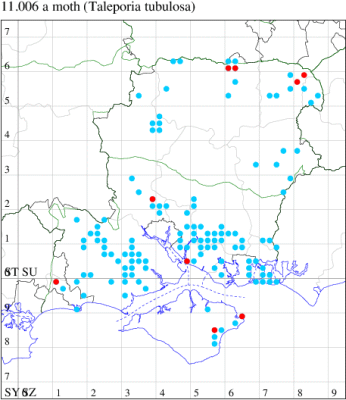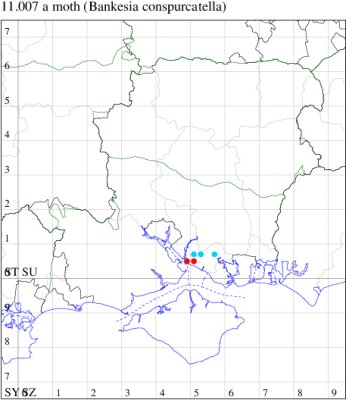2021 Annual Report for: Psychidae / Taleporiinae
For species seen in 2021 that had less than or equal to 100 records, full details are included; for more common species, the earliest, latest and highest count by vice-county are shown. The narrative for each species is taken from the main Hantsmoths website, and it is possible that some information on abundance and occurrence can get out of date, as it is impossible to keep up with all changes; however it should give a good introduction to each species. The tables in each species account summarise the previous status, and that for the current year.
For the maps, all records prior to 2021 are shown by a blue dot (the larger the dot, the more recent), with the current year's records shown in red. As previous records are superimposed on any report for 2021, new sites have greater emphasis (i.e. will show as 'more red').
In the species accounts, an asterisk next to a location indicates a new 10km square record; earliest ever dates are highlighted in orange, and latest ever in red. Initials in the species accounts refer to the recorders listed here. Please get in touch if you identify any omissions or errors, in particular if you have records that have yet to be submitted. Details of how to submit records can be found here.
11.006 [B&F: 0181] Taleporia tubulosa (Retzius, 1783) - Local
Local in woodland and rough meadows throughout much of the British Isles. In Hampshire cases can be found in woodland, on rocks and old walls, and are widespread and common on the mainland, although there are no recent record from the Isle of Wight. Wingspan male 15-20 mm, female wingless. The adult moths are seen occasionally, but most records are of larval cases. Larva feeds on various lichens, dead insects and decaying vegetable matter, living within a movable case, over-wintering once or twice. The case is constructed of silk coated with lichen, fine sand and bark, and can be found.
Records prior to 2021
| Vice County | #Records | #Individuals | First Record | Last Record |
|---|---|---|---|---|
| 10 | 12 | 18 | 1856 | 2020 |
| 11 | 284 | 274 | 1972 | 2020 |
| 12 | 99 | 134 | 1976 | 2020 |
2021 records
| Vice County | #Records | #Individuals | Max Quantity |
|---|---|---|---|
| 10 | 2 | 3 | 2 |
| 11 | 3 | 3 | 2 |
| 12 | 8 | 15 | 3 |

Records by year
Records by week (adult)
Records by week (larval)
Record Details
VC10: Alverstone, larva, one, field observation, one larval case on metal pipe, 16 Jul; Bembridge, larva, two, field observation, on wall of house at same site as recorded in 2020: larval cases both with exuviae, 11 Jul (PBar);
VC11: Romsey, one, 20 Jun (NRJ); Hook Lake NR, case, two, field observation, cases on fence, 21 Mar (RJD, ADT); Merritown Heath, present, 10 Jun (DFoo);
VC12: Pamber Forest, two, 09 Jun; two, 11 Jun; three, 16 Jun (GJD); Minley Wood, case, two, field observation, 18 Apr; Yateley Common, case, three, field observation, 07 Feb; case, one, field observation, 11 Feb; case, one, field observation, 27 Mar; case, one, field observation, 02 Aug (BDal)
11.007 [B&F: 0182] Bankesia conspurcatella (Zeller, 1850) - pRDB1
Endangered (proposed as a future Red Data Book species) in Hampshire and Kent, where it was rediscovered in 1984, and Yorkshire; recently also found in an urban context in Mynachdy, Cardiff. Not recorded from the Isle of Wight to date. There has been some discussion amongst authors as to the identity of the species found in Britain; formerly it was believed to be Dahlica (Bankesia) douglasii, but presently it is assigned to B. conspurcatella. The adult moths are seen occasionally, but most records are of larval cases. Larva feeds on lichens growing on tree trunks, fence posts and rocks, living within a movable case, over-wintering as a pupa.
Records prior to 2021
| Vice County | #Records | #Individuals | First Record | Last Record |
|---|---|---|---|---|
| 11 | 39 | 271 | 1994 | 2020 |
2021 records
| Vice County | #Records | #Individuals | Max Quantity |
|---|---|---|---|
| 11 | 8 | 61 | 20 |

Records by year
Records by week (adult)
Records by week (larval)
Record Details
VC11: Hook Valley NR*, 19, in flight, 21 Mar (RJD, ADT det. DPH); Warsash Common, one, field observation, male in flight in the morning; a visit on 20th had produced none, 24 Feb (DPH); one, field observation, 02 Mar (ADT); 20, field observation, 21 Mar (RJD det. DPH); five, field observation, males in flight, 27 Mar; six, field observation, males in flight, 27 Mar (DPH); eight, field observation, 24 Mar; one, field observation, male conf. RJD, 02 Mar (ADT)